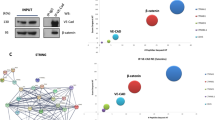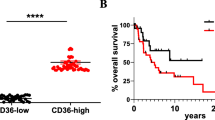Abstract
Background
Vasculogenic mimicry (VM) is a tumor angiogenesis process in which highly aggressive melanoma cells form patterned, tubular networks in an in vitro, three-dimensional culture that mimics vasculogenic networks formed by endothelial cells. These cells also express endothelial cell-associated genes such as vascular endothelial–cadherin (VE–cadherin) and are correlated with poor clinical prognosis in patients. However, the molecular underpinnings of this phenomenon remain elusive.
Methods
Three-dimensional cultures of highly and poorly aggressive uveal melanoma cells were observed by inverted light microscope and scanning electronic microscope for VM. RNAi (RNA interference) technology was used to examine whether inhibitor of DNA binding 2 (Id2) was involved in the uveal melanoma vasculogenic mimicry. Western blot analysis showed changes of Id2 and VE-cadherin expression in highly and poorly aggressive melanoma cells in vitro. Migration analysis of highly and poorly aggressive uveal melanoma cells in vitro illuminated the role of Id2 in tumor cells migration.
Results
We show here that a transient knockdown of Id2 by RNA interference abrogates VM and VE-cadherin expression in highly aggressive uveal melanoma cells. Furthermore, inhibition of Id2 changes cellular stability and creates a more dynamic condition. Transfected cells also migrate better than untransfected cells.
Conclusions
This study shows that Id2 is an important regulator of VM. Specifically, Id2 affects VE-cadherin expression, and is critical for the formation of vasculogenic-like networks.





Similar content being viewed by others
References
Egan KM, Seddon JM, Glynn RJ, Gragoudas ES, Albert DM (1988) Epidemiologic aspects of uveal melanoma. Surv Ophthalmol 32:239–251. doi:10.1016/0039-6257(88)90173-7
McLean IW (1993) The biology of haematogenous metastasis in human uveal malignant melanoma. Virchows Arch A Pathol Anat Histopathol 422:433–437. doi:10.1007/BF01606450
Maniotis AJ, Folberg R, Hess A, Seftor EA, Gardner LM, Pe’er J, Trent JM, Meltzer PS, Hendrix MJ (1999) Vascular channel formation by human melanoma cells in vivo and in vitro: vasculogenic mimicry. Am J Pathol 155:739–752
Hendrix MJ, Seftor EA, Meltzer PS, Gardner LM, Hess AR, Kirschmann DA, Schatteman GC, Seftor RE (2001) Expression and functional significance of VE-cadherin in aggressive human melanoma cells: role in vasculogenic mimicry. Proc Natl Acad Sci USA 98:8018–8023. doi:10.1073/pnas.131209798
Hess AR, Seftor EA, Gardner LM, Carles-Kinch K, Schneider GB, Seftor RE, Kinch MS, Hendrix MJ (2001) Molecular regulation of tumor cell vasculogenic mimicry by tyrosine phosphorylation: role of epithelial cell kinase (Eck/EphA2). Cancer Res 61:3250–3255
Seftor RE, Seftor EA, Koshikawa N, Meltzer PS, Gardner LM, Bilban M, Stetler-Stevenson WG, Quaranta V, Hendrix MJ (2001) Cooperative interactions of laminin 5 gamma2 chain, matrix metalloproteinase-2, and membrane type-1-matrix/metalloproteinase are required for mimicry of embryonic vasculogenesis by aggressive melanoma. Cancer Res 61:6322–6327
Riechmann V, Sablitzky F (1995) Mutually exclusive expression of two dominant-negative helix-loop-helix (dnHLH) genes, Id4 and Id3, in the developing brain of the mouse suggests distinct regulatory roles of these dnHLH proteins during cellular proliferation and differentiation of the nervous system. Cell Growth Differ 6:837–843
Itahana Y, Singh J, Sumida T, Coppe JP, Parrinello S, Bennington JL, Desprez PY (2003) Role of Id-2 in the maintenance of a differentiated and noninvasive phenotype in breast cancer cells. Cancer Res 63:7098–7105
Stighall M, Manetopoulos C, Axelson H, Landberg G (2005) High ID2 protein expression correlates with a favourable prognosis in patients with primary breast cancer and reduces cellular invasiveness of breast cancer cells. Int J Cancer 115:403–411. doi:10.1002/ijc.20875
Russell RG, Lasorella A, Dettin LE, Iavarone A (2004) Id2 drives differentiation and suppresses tumor formation in the intestinal epithelium. Cancer Res 64:7220–7225. doi:10.1158/0008-5472.CAN-04-2095
Lasorella A, Rothschild G, Yokota Y, Russell RG, Iavarone A (2005) Id2 mediates tumor initiation, proliferation, and angiogenesis in Rb mutant mice. Mol Cell Biol 25:3563–3574. doi:10.1128/MCB.25.9.3563-3574.2005
Onken MD, Ehlers JP, Worley LA, Makita J, Yokota Y, Harbour JW (2006) Functional gene expression analysis uncovers phenotypic switch in aggressive uveal melanomas. Cancer Res 66:4602–4609. doi:10.1158/0008-5472.CAN-05-4196
Gumbiner BM (1996) Cell adhesion: the molecular basis of tissue architecture and morphogenesis. Cell 84:345–357. doi:10.1016/S0092-8674(00)81279-9
Hynes RO (1992) Specificity of cell adhesion in development: the cadherin superfamily. Curr Opin Genet Dev 2:621–624. doi:10.1016/S0959-437X(05)80182-0
Seftor EA, Meltzer PS, Kirschmann DA, Pe’er J, Maniotis AJ, Trent JM, Folberg R, Hendrix MJ (2002) Molecular determinants of human uveal melanoma invasion and metastasis. Clin Exp Metastasis 19:233–246. doi:10.1023/A:1015591624171
Kan-Mitchell J, Mitchell MS, Rao N, Liggett PE (1989) Characterization of uveal melanoma cell lines that grow as xenografts in rabbit eyes. Invest Ophthalmol Vis Sci 30:829–834
Marone M, Mozzetti S, De Ritis D, Pierelli L, Scambia G (2001) Semiquantitative RT-PCR analysis to assess the expression levels of multiple transcripts from the same sample. Biol Proced Online 3:19–25. doi:10.1251/bpo20
Desprez PY, Sumida T, Coppe JP (2003) Helix-loop-helix proteins in mammary gland development and breast cancer. J Mammary Gland Biol Neoplasia 8:225–239. doi:10.1023/A:1025957025773
Hess AR, Seftor EA, Gruman LM, Kinch MS, Seftor RE, Hendrix MJ (2006) VE-cadherin regulates EphA2 in aggressive melanoma cells through a novel signaling pathway: implications for vasculogenic mimicry. Cancer Biol Ther 5:228–233
Hess AR, Seftor EA, Seftor RE, Hendrix MJ (2003) Phosphoinositide 3-kinase regulates membrane Type 1-matrix metalloproteinase (MMP) and MMP-2 activity during melanoma cell vasculogenic mimicry. Cancer Res 63:4757–4762
Khwaja A, Lehmann K, Marte BM, Downward J (1998) Phosphoinositide 3-kinase induces scattering and tubulogenesis in epithelial cells through a novel pathway. J Biol Chem 273:18793–18801. doi:10.1074/jbc.273.30.18793
Folberg R, Rummelt V, Parys-Van Ginderdeuren R, Hwang T, Woolson RF, Pe’er J, Gruman LM (1993) The prognostic value of tumor blood vessel morphology in primary uveal melanoma. Ophthalmology 100:1389–1398
Sakamoto T, Sakamoto M, Yoshikawa H, Hata Y, Ishibashi T, Ohnishi Y, Inomata H (1996) Histologic findings and prognosis of uveal malignant melanoma in Japanese patients. Am J Ophthalmol 121:276–283
Folberg R, Arbieva Z, Moses J, Hayee A, Sandal T, Kadkol S, Lin AY, Valyi-Nagy K, Setty S, Leach L, Chevez-Barrios P, Larsen P, Majumdar D, Pe’er J, Maniotis AJ (2006) Tumor cell plasticity in uveal melanoma: microenvironment directed dampening of the invasive and metastatic genotype and phenotype accompanies the generation of vasculogenic mimicry patterns. Am J Pathol 169:1376–1389. doi:10.2353/ajpath.2006.060223
Acknowledgements
The authors gratefully acknowledge access to human uveal melanoma cell lines kindly provided by Dr. Mary J.C. Hendrix, Dr. Elisabeth A. Seftor, Dr. Cheng and Dr. Freeman, in addition to thanking Dr. Meihong Chen for helpful scientific discussion and Dr. J. Jonas for careful review. The authors are also grateful for the support from the Beijing Municipal Natural Science Foundation (7053065).
Author information
Authors and Affiliations
Corresponding author
Additional information
Grant
Beijing Municipal Natural Science Foundation (7053065).
Rights and permissions
About this article
Cite this article
Su, F., Li, B., Wang, J. et al. Molecular regulation of vasculogenic mimicry in human uveal melanoma cells: role of helix–loop–helix Id2 (inhibitor of DNA binding 2). Graefes Arch Clin Exp Ophthalmol 247, 411–419 (2009). https://doi.org/10.1007/s00417-008-1008-z
Received:
Revised:
Accepted:
Published:
Issue Date:
DOI: https://doi.org/10.1007/s00417-008-1008-z




